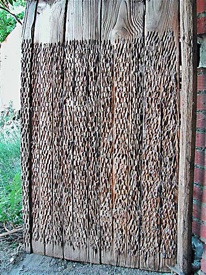 National Geographic has a fine feature called Photo of the Day. Today’s shows a Spanish farmer with a wooden, sled-like contraption with sharp rocks embedded in the bottom. It’s a threshing board, used at harvest time to cut up straw, separate cereal grains from chaff and break open chickpea pods. Now, unfortunately I can’t just take the NatGeo photo and put it up here for you to see, you’ll just have to go to their site, but I did look around for an illustration that was in the public domain, and I found it at Answers.com, in a fascinating article on the history of these tools. The NatGeo photo is worth seeing, though. While surfing, I also ended up at the Food Museum Online, which I’d never come across before. It’s not the prettiest looking site, but it has some great content, including illustrations of traditional farming practices and tools. There’s also a blog, with a feed.
National Geographic has a fine feature called Photo of the Day. Today’s shows a Spanish farmer with a wooden, sled-like contraption with sharp rocks embedded in the bottom. It’s a threshing board, used at harvest time to cut up straw, separate cereal grains from chaff and break open chickpea pods. Now, unfortunately I can’t just take the NatGeo photo and put it up here for you to see, you’ll just have to go to their site, but I did look around for an illustration that was in the public domain, and I found it at Answers.com, in a fascinating article on the history of these tools. The NatGeo photo is worth seeing, though. While surfing, I also ended up at the Food Museum Online, which I’d never come across before. It’s not the prettiest looking site, but it has some great content, including illustrations of traditional farming practices and tools. There’s also a blog, with a feed.
Photo of a Spanish “trillo” by José-Manuel Benito